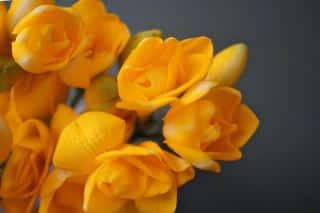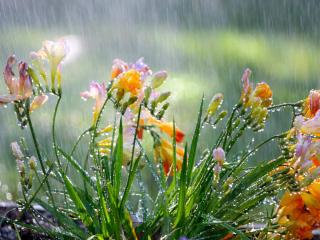

Freesia is a superb bulb flower, both extremely ornamental and fragrant.
Key Freesia Facts
Name – Freesia
Family – Iridaceae
Type – bulb plant
Height – 10 to 24 inches (25 to 60 cm)
Exposure – full sun
Soil: sandy and light – Flowering: summer → early fall, or February-March (forced in pots)
Caring for it from planting to pruning is quite easy and the result will often enchant you.
If your climate allows for it, plant the bulbs at the beginning of spring, towards February-March, more or less 1 to 1½ inches (3/4 cm) deep.

Freesia revels in the sun and in rather rich and especially well-drained soil. Since this plant is relatively vulnerable to the cold, it will prefer the warmest and sunniest spot of the garden.
Whether you’re a seasoned gardener or a greenhorn newbie, Freesia is the perfect plant for you because it only requires little care.
However, some steps are important to consider if you want to extend the blooming and avoid diseases.
Watering and fertilizing freesia

Pruning freesia
Pruning of your freesia plant isn’t a requirement, but it may enhance blooming.
Freesia in winter
Freesia cannot withstand temperatures below freezing and must be brought out from the cold in winter. Since it is often pot-bound or grown in containers, it’s much easier to bring the bulbs under shelter from freezing.
The trumpet-shaped flowers appear in bunches at the tip of floral scapes and bring bright, eye-catching colors like red, violet, yellow or white, depending on the variety.
Note also that the freesia is particularly fragrant and is often included in perfume scents.
The name Freesia itself dates back to 1866 and was christened by a botanist called Ecklon to honor a German doctor whose name was “Freese”.
If you plant your bulbs in clusters of 30 or more, you’ll be creating magnificent spots of color in your garden!
C’est tres bien ! Lhistoire dorigin est mieu pour connaiser Les plantes. Jai freesias mais abeil ( bees) ici n’aime Pas leur parfum! ILS preferent campanulas petite et ordinaire. Nature EST com CA.
Hehe thanks for your comments Rose! Here’s a translation for our English-speaking readers:
That’s really great! Knowing about where the plants come from helps understand them better. I have Freesia but bees don’t find their fragrance very attractive. They’d rather visit the simple, tiny bellflower! That’s how nature is!